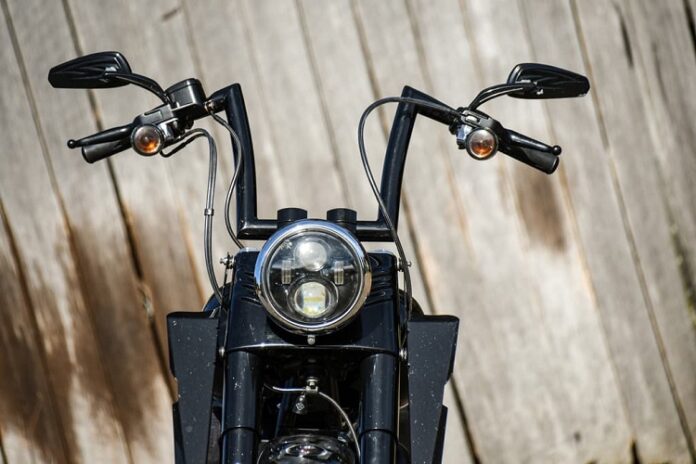STEEL, ALUMINIUM OR CARBON
Deciding on which to go for – steel, aluminum or carbon. The choice here is dependent on your budget; Traskperformance.com would suggest you choose a motorcycle handlebar that meets your needs.
The steel handlebar is more resistant, but heavier and less original in shape (no variable diameter). It corresponds to the material of the original handlebars, and therefore to their shape and dimensions. It is solid but hardly breaks in the event of a fall. Another advantage: it is not expensive!
The aluminum handlebar is lightweight and has diverse shapes, but it can break easily in case of a fall. On the other hand, it can be repaired more easily than steel or carbon. It is a preferred choice if you need a handlebar that isn’t wide. Known for its lightness, the aluminum has the distinction of being referred to as a “rigid” metal. In the continuity of the fork, it offers a perfect feedback on the front axle. Gross or in anodized version, the aluminum makes it possible to produce handlebars of variable diameter (i.e. larger diameter at the level of the bridges). Nevertheless, it is known to be more expensive and fragile in case of fall.
Carbon is light, flexible, but excessively expensive and particularly fragile in the event of a fall.
The majority of the standard motorcycles are equipped with steel handlebars. They are inexpensive for the manufacturer, the alloy composed of iron and carbon nevertheless remains very resistant. It is also comfortable due to its composition – steel is a “soft” metal that absorbs vibrations. It has the advantage of being produced in chrome finishing, which the aluminum does not have (a thin layer of the aluminum prevents the deposit of chromium by electrolysis). However, the steel motorcycle handle is quite heavy and can get rusty in the long-run.
SHAPES AND DIMENSIONS
There are many shapes and dimensions of handlebars. A handlebar is also called a hanger: it usually has two elbows giving it its shape. The first elbow conditions the position of the arms; the second elbow places the hands. A handlebar greatly influences the driving position and ease of handling.
A motorcycle handlebar is generally bent, i.e. it has elbows. The length of the tubes and the angles define the steering style. The first elbow defines the height of the handlebars and therefore of your wrists. The second influences the position of your hands, whether they are more or less open or closed. Also, the width of the hanger will define the gap between your elbows and your bust.
A high and curved handlebar that bends towards the driver brings you a comfortable position with the elbows close to the body and the back straightened.
A wide, low and straight handlebar lets you have your elbows well apart and have your body weight on the front for a more incisive position.
Dedicated to sports, the raised handlebars give you a less fatiguing posture on a daily basis by straightening your back.
Do not choose a handlebar lightly: doing this could result in errors and difficulties in handling the motorcycle and also cause you, pains. The ergonomics of a motorcycle count considerably for its driving.
Be sure to check the diameter of your handlebar on the level of the bridges. The large standard is 22 mm, 25 mm for custom and 28 mm for oversize handlebars, but it can vary according to the original equipment.
TYPES OF HANDLEBARS
There are several types of handlebars, and each type has its variations.
Regular Handlebars: These are much-raised handlebars which place the hands high enough.
Roadster Handlebars: There is the link between the custom handlebar and the flat handlebars. That is to say; there are three variations in this: high, medium and low.
Flat Handlebars: Hardly bent, these handlebars are as much an aesthetic choice as a desire to have a larger arm lever. As the name suggests, they have very little bending.
The Cross Handlebars: They are generally robust, and can have a central reinforcement bar. Note, their dimensions are often over-dimensioned, and all the fork bridges cannot accommodate them.
THE INSIDE AND OUTSIDE DIMENSION OF THE HANDLEBARS
When it comes to the inside diameter of the handlebar tube, there are two options – you can either choose to retrieve the original handlebars (otherwise called “flyweights” or “handlebar weight”), or you choose new models. Whichever you choose, the inside diameter of the handlebars sets the model to choose. There are two inside diameters: one wide (mm) and one narrow (mm). Do not overlook the significance of the handlebars: they do not only serve in case of a fall but balances the motorcycle and eliminates a certain number of vibrations.
Consequently, with regards to the outside diameter of the handlebar tube, if you do not change the original fork bridges (the elements that bind the handlebars and the upper fork tee); you must opt for a handlebar that has the same outside coat as the original handlebars.
There are 2 or 3 outer handlebar diameters: standard and oversize. Do not forget to check the inside diameter.
Whatever the case may be, whether it is a simple aesthetic choice or a real comfort issue, the motorcycle handlebar is a centerpiece of driving position. A new hanger can transform your motorcycle.
Traskperformance.com is presently one of the leaders in the distribution of motorcycle and bikers’ equipment and accessories online.
Traskperformance.com is owned and operated by a passionate team of [number of people] who work daily to advise and accompany motorcyclists and bikers. We offer the best brands, the best products, the best prices on the internet, with ever greater choices to select from














